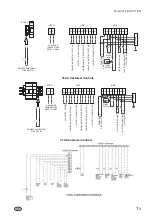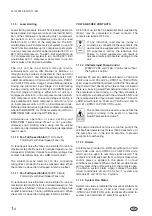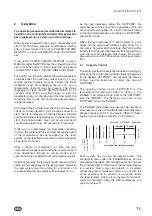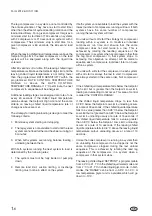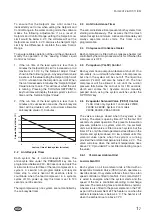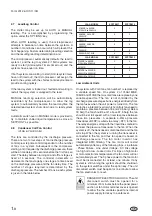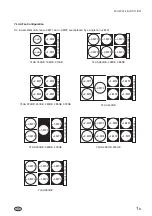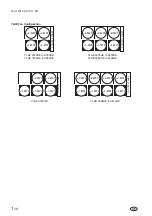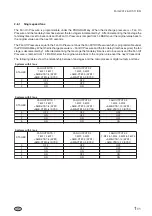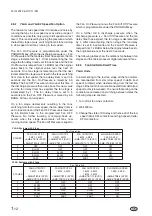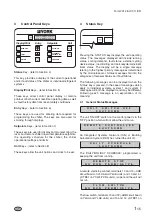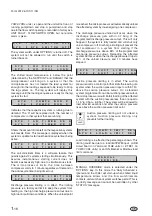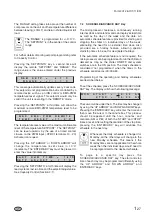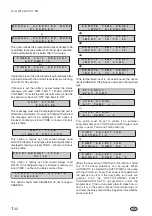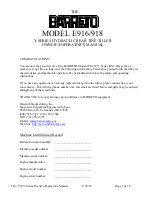
'MANUAL OVERRIDE' is to only be used in
emergencies or for servicing. 'MANUAL
OVERRIDE' mode automatically disables
itself after 30 minutes.
Indicates that a compressor in the respective system is
pumping the system down. When pumpdown is
initiated, the liquid line solenoid will close and a
compressor will continue to run. When the suction
pressure decreases to the suction pressure cutout, the
compressor will cycle off. If pump down cannot be
achieved within three minutes of the liquid line solenoid
closure, the compressor will cycle off.
4.2
Fault Status Messages
Safeties are divided into two categories - system
safeties and unit safeties. System safeties are faults that
cause the individual system to be shut down. Unit
safeties are faults that cause all running compressors to
be shut down.
System Safeties
System safeties are faults that cause individual systems
to be shut down if a safety threshold is exceeded for
3 seconds. The system will be allowed to restart
automatically after the fault condition is no longer
present. However, if 3 faults on the same system occur
within 90 minutes, that system will be locked out on the
last fault. This condition will require a manual reset using
the system switch (under 'OPTIONS' key). The switch
must be turned off and then back on to clear the lockout
fault.
The software discharge pressure cut-out is backed-up
by a mechanical high pressure cut-out switch located in
each refrigerant circuit. The software cut-out assures
that the system pressure does not exceed safe working
l i m i t s . T h e s y s t e m w i l l s h u t d o w n w h e n t h e
programmable cut-out is exceeded and will be allowed
to restart when the discharge pressure falls below the
cut-out.
The software suction pressure cut-out protects the
chiller from an evaporator freeze-up should the system
attempt to run with a low refrigerant charge or a
restriction in the refrigerant circuit.
At system start, the cut-out is set to 10% of programmed
value. During the next 3 minutes the cut-out point is
ramped up to the programmed cut-out point. If at any
time during this 3 minutes the suction pressure falls
below the ramped cut-out point, the system will stop.
This cut-out is ignored for the first 30 seconds of system
run time to avoid nuisance shutdowns.
After the first 3 minutes, if the suction pressure falls
below the programmed cut-out setting, a 'transient
protection routine' is activated. This sets the cut-out at
10% of the programmed value and ramps up the cutout
over the next 30 seconds. If at any time during this 30
seconds the suction pressure falls below the ramped
cutout, the system will stop.
The Motor Protector (-FMP) / Compressor Overload
(-KCOL) / Mechanical High Pressure Cut-outs (-FHP)
protect the compressor from overheating, overcurrent
or the system from experiencing dangerously high
discharge pressure. Compressor overloads are not
fitted to YLAA units.
This fault condition is present when relays
(1-K1 (system 1) or 2-K1 (system 2) on
YCWL/YCRL units or -ARB K20 (system 1) or
-ARB K21 (system 2) on YLAE/YLAA units)
de-energise due to the -FHP cut-out, or the
-FMP opening, or the -KCOL tripping.
-FMP
The compressor electronic modules are connected to
the motor winding temperature sensors and an internal
discharge temperature sensor. The -FMP opens when
the discharge temperature is above 140°C or when the
winding temperature rises above the trip temperature.
The winding and discharge sensors are connected in
series and have a trip resistance of 4.5 k
W ±
20%, reset
is less than 2.75 k
W
. The compressor electronic module
has a 30
±
5 minute reset delay after the sensor reset
resistance is reached. For compressors with no
electronic module, the compressor has thermostats
imbeded in the motor winding whose contacts open on
high motor temperatures. when the motor cools the
contacts will close again.
1
-
17
Form 201.26.OI1(11/09)
S Y S
1
P U M P I
N G
D O W N
S Y S
2
P U M P I
N G
D O W N
S Y S
1
H I
G H
D S C H
P R E S
S Y S
2
H I
G H
D S C H
P R E S
S Y S
1
L O W
S U C T
P R E S S
S Y S
2
L O W
S U C T
P R E S S
S Y S
1 M P /
H P C O
I
N H I
B I
T
S Y S
2 M P /
H P C O
I
N H I
B I
T
OR
S Y S
1
M P /
H P C O
F A U L T
S Y S
2
M P /
H P C O
F A U L T

